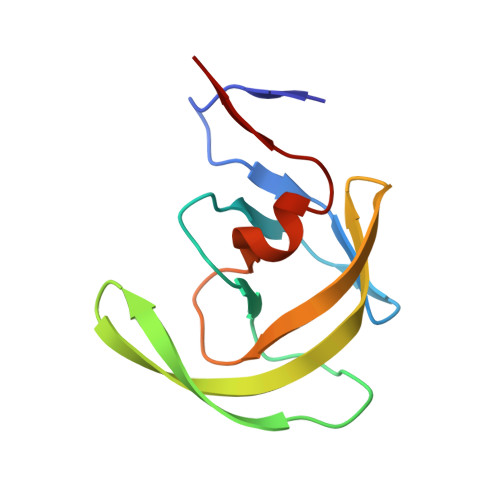Role of hydroxyl group and R/S configuration of isostere in binding properties of HIV-1 protease inhibitors
Petrokova, H., Duskova, J., Dohnalek, J., Skalova, T., Vondrackova-Buchtelova, E., Soucek, M., Konvalinka, J., Brynda, J., Fabry, M., Sedlacek, J., Hasek, J.(2004) Eur J Biochem 271: 4451-4461
- PubMed: 15560786
- DOI: https://doi.org/10.1111/j.1432-1033.2004.04384.x
- Primary Citation of Related Structures:
1M0B - PubMed Abstract:
The crystal structure of the complex between human immunodeficiency virus type 1 (HIV-1) protease and a peptidomimetic inhibitor of ethyleneamine type has been refined to R factor of 0.178 with diffraction limit 2.5 A. The peptidomimetic inhibitor Boc-Phe-Psi[CH2CH2NH]-Phe-Glu-Phe-NH2 (denoted here as OE) contains the ethyleneamine replacement of the scissile peptide bond. The inhibitor lacks the hydroxyl group which is believed to mimic tetrahedral transition state of proteolytic reaction and thus is suspected to be necessary for good properties of peptidomimetic HIV-1 protease inhibitors. Despite the missing hydroxyl group the inhibition constant of OE is 1.53 nm and it remains in the nanomolar range also towards several available mutants of HIV-1 protease. The inhibitor was found in the active site of protease in an extended conformation with a unique hydrogen bond pattern different from hydroxyethylene and hydroxyethylamine inhibitors. The isostere nitrogen forms a hydrogen bond to one catalytic aspartate only. The other aspartate forms two weak hydrogen bridges to the ethylene group of the isostere. A comparison with other inhibitors of this series containing isostere hydroxyl group in R or S configuration shows different ways of accommodation of inhibitor in the active site. Special attention is devoted to intermolecular contacts between neighbouring dimers responsible for mutual protein adhesion and for a special conformation of Met46 and Phe53 side chains not expected for free protein in water solution.
Organizational Affiliation:
Institute of Macromolecular Chemistry, Academy of Sciences of the Czech Republic, Praha, Czech Republic. petrokova@imc.cas.cz
















